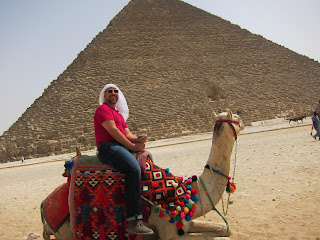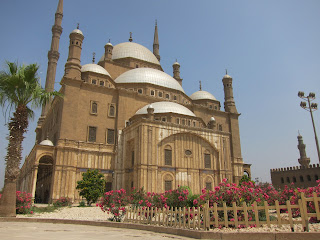Cairo. The mystical land of the Pharaohs. We land at night. Looking out the airplane window, the city lights go on for miles. Modern Egypt is home to the largest Arab speaking people in the world. The population has now reached almost 85 million people. Greater Cairo itself is home to almost 25 millions. We get out of the airport, walk into the hot night air and meet our taxi.
The drive to the airport takes about 45 minutes. We are staying at the Mena House Oberoi in Giza (http://www.oberoihotels.com/oberoi_menahouse/index.asp), near the great pyramids in suburban Cairo. I decided to avoid hotels downtown after all the news about insecurity and political troubles I saw on TV.

After a restful night, we walk out to meet our guide for the start of our visit. The hotel grounds were beautifully manicured. Luckily the weather cooled down and we experienced a pleasant 3 days of 85 degree weather. We wander though the gardens, admiring the blooming royal poincianas, the orange trees and date palms before leaving the hotel.
The hotel is a fantastic old royal hunting lodge that was modified in the late 1800 and turned into a five-star property. The service, the accommodations, the grounds are all first rate. Never did we feel scared or concerned by the "situation". We found out right before leaving home that Egypt was holding its first free presidential elections during our visit. People were warm and friendly and thanked us for coming to visit their country despite the bad press. In retrospect we should have stayed downtown where one can find all the action.
Cairo is a surprising mix of thousands of years of tradition and modernity. People wearing the traditional jellabas, men dressed in smart western suits, women with headscarves next to women dressed as if they were in Miami Beach along yet another group of women completely covered and veiled. The roads are packed with cars zipping past carriages heavy with produce from the nearby Nile banks.
Donkeys, horses and camels are everywhere, sharing the road with cars, trucks and buses. Freeways with 6 lanes of traffic in each direction are completely paralyzed by traffic 24 hours a day. Unfortunately driving is a high risk sport because of people crossing in front of traffic even on the freeways. Very few traffic lights exist, and most of those are not in operation. Somehow things seem to move and function despite the chaos. Poor sanitation, flies and mosquitos, dust from the desert and the lack of trash collection from most neighborhoods negatively taint the whole experience.
Our visit start in the old city remnants of Memphis. The highlight is the unfinished statue of Ramses II.
From there we head to Saqqara, the sight of the first pyramid. Several pyramids, mastabas and a very large necropolis pepper the area. The site was already a tourist attraction over 3000 years ago. Hieroglyphic graffiti from earlier tourists are a testament to the importance of the sight throughout history.
Souvenir peddlers and hustlers are everywhere. With the recent troubles in Egypt, tourists are scarce. I promise myself not to let them talk me into anything I don't really need.
I am approached by a nice man pulling a donkey. He approaches me by asking me if I was Egyptian. When I tell him that I am not, he offers me a head scarf. Even though I tell him that I am not looking to buy anything, he assures me that this is only a gesture of friendship. He then asks me to get on the donkey so he can snap a picture of me in front of the pyramid. After much insistence, I get on the donkey, let him snap a few pictures. There! I was guilted into giving him a tip. I promise myself that I will not fall for the next one.
After a quick lunch, we head to the site of the great pyramids of Giza and the Sphinx. This is truly an awe inspiring sight. Three large pyramids and many other small ones reserved for the wives and mothers of the kings on a bluff overlooking modern Cairo in the distance. The genius of the ancient Egyptians is evident everywhere. How could they have built such amazing structures, with so much mathematical precision many thousand years ago? The modern Egyptian is also very clever albeit in a different way. I am approached by a headscarf vendor who offers me a free headscarf. Despite my protests, he doesn't give up until I reluctantly agree. I caution him that I will not buy his scarf, nor give him a "tip". No problem. I am then approached by a guy with a camel. Business is bad he tells me. He thanks me for coming to his country in spite of all the negative publicity in the news. As a gesture of his appreciation, I am offered a free camel ride. Just a few minutes he tells me. When I decline, he feigns being offended. I feel bad for them and ask for a price. I am told it is free and nothing is expected from me. Reluctantly I get on and just as quickly as the camel gets up I acknowledge to myself that I have been conned again. I end up spending the $40 that I had in my wallet. Double the usual cost. I am glad I had hidden the rest of my money in my socks.
Back at the hotel, we quickly freshen up and head to downtown Cairo. The sun is setting and the city is awakening. Tables are put outside everywhere we look. Sidewalks, median dividers and every inch of not so green space is turned into an outdoor cafe. Men sit by themselves, smoking water pipes, drinking coffee, discussing politics and playing backgammon. The women are also outside enjoying the cooler air and doing the same with their friends while young children are running around laughing and playing.
Downtown is also alive although the crowd is more affluent. Cafes along the Nile are full. Small boats brightly lit with colorful Christmas lights take families for sunset cruises. We are headed for a dinner cruise and a show of traditional dancing. Egyptian food is a disappointment. Being of Lebanese descent, I am used to some of the best middle eastern food. This is clearly not a culinary destination.
The show starts with a middle age belly dancer with obscenely augmented breasts that she proudly features in a skimpy red bikini top.
Fortunately the second act is much more impressive. A Sufi dancer spends more than half an hour spinning in a trance-like state. The crowed is electrified. After a captivating performance, he picks a few volunteers from the crowd to teach his dance. They become completely disoriented after just a few minutes of spinning, confirming the degree of difficulty of his performance. Our first full day in Cairo comes to an end.
The next day, we head back into town. First stop is the Salah al din (Saladin) citadel. Built to defend the city from the Crusaders, the complex is an 11th century fortress high on a bluff overlooking the old city and the nearby Nile. We wander though the narrow streets and visits the two mosques where we are treated to an abridged version of Muslim history.
The older al Nasir mosque dates from the Mamluk period (1318). When the Ottoman ended the Mamluk dynasty, their leader Mohamed Ali Pasha built and impressive new mosque in the Byzantine style on the site of the Mamluk’s palace (1828).
 |
| Byzantine minarets on left, older Mamluk minaret on right. |
 |
| Mosque of Mohamed Ali |
 |
| Courtyard with fountain of ablutions, mosque of Mohamed Ali |
From the grounds outside the mosque we admire old Cairo.
Cairo is also a cradle of Christianity. We head to the Coptic center of town where we visit some of the oldest churches in the world, built on sites visited by the holy family during their stay in Egypt, after the massacre of the Innocents.
We also visit the synagogue of Ben Ezra built and rebuilt reportedly on the site where Moises was rescued from the water.

Finally we make a quick stop at the local souq, the Khan al Khalili, for a little shopping.

Finally we make a quick stop at the local souq, the Khan al Khalili, for a little shopping.
Most of the afternoon is spent admiring the treasures of pharaonic Egypt at the National Museum of Antiquities. Located in Tahrir square in central Cairo, the museum is the oldest structure built specifically to house a museum. Next door is a recently bombed and burned headquarter of a political party.

An extensive collection is displayed on 2 floors. Large statues on the ground floor, smaller statues, papyruses,mummies and jewelry are on the upper floor. The treasure rooms are the undisputed highlight of the museum. 3 large rooms are dedicated to the treasures of a few pharaohs the best known one being Toutankhamon, the boy king. Toutankhamun treasures leave us breathless. Seeing the funerary masks including the solid 24 pound gold one, solid gold coffin and large trove of jewelry is a real treat. We wonder freely in the nearly empty museum admiring other more modest but still priceless artifacts dating back many more thousands of years.
On the way to the airport the next day, I reflect on the last 48 hours as we drive along the beautifully manicured avenues of Heliopolis. Egypt is really the cradle of modern civilization. Our civilization has benefited enormously from the ancient Egyptians and the thousands of years they spent inventing much of what we use today in our every day lives. They still try to hold on to many ancient traditions while trying to find a way to embrace the advances of the modern world.
I can hardly wait to come back. There is still an enormous chapter waiting for me to discover: the valley of the kings, Luxor (ancient Thebes), Alexandria and also the desert oases that offer yet another aspect of Egyptian life and history.

































































































No comments:
Post a Comment